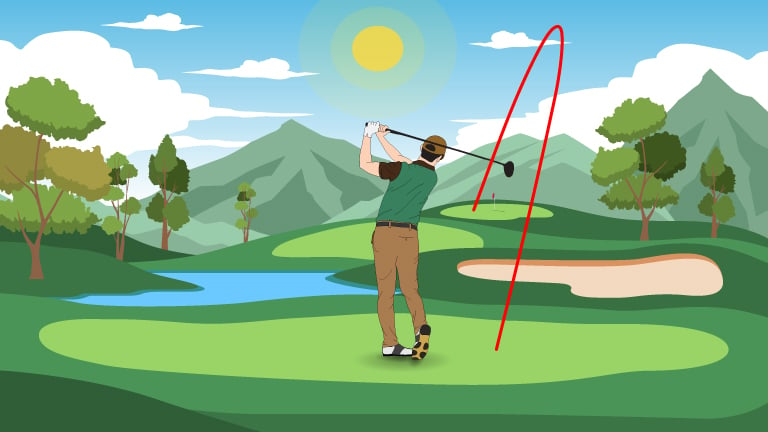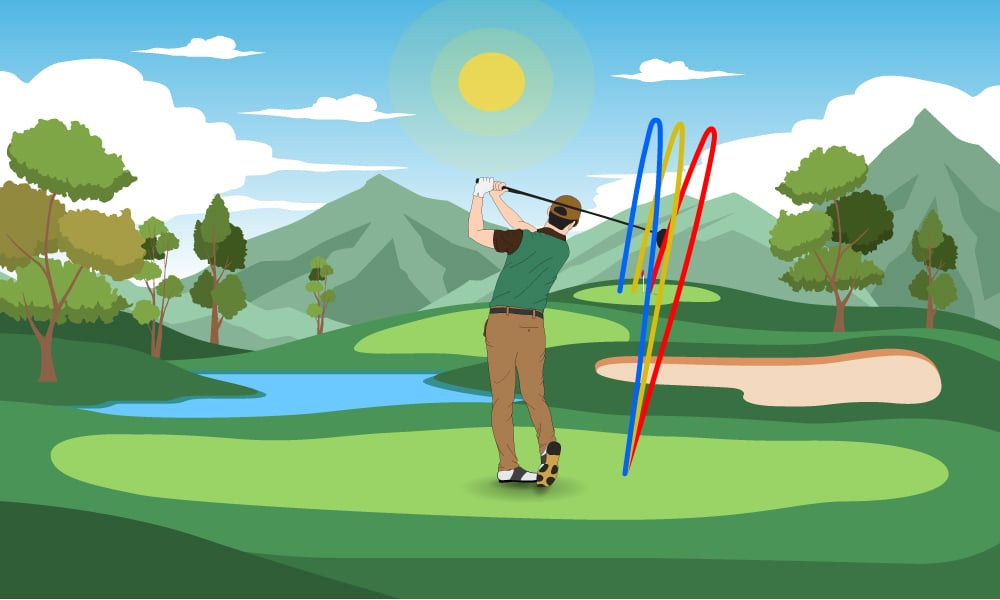As any golfer knows, mastering different types of shots can be a challenging yet rewarding experience. One such shot that has confounded many golfers is the draw shot. However, even though it may seem complicated to learn at first, the draw shot is a useful skill on the golf course. It can help you avoid obstacles, reach certain distances more accurately, and improve your game.
But how do you hit a draw shot? You must practice and be patient to hit a draw shot consistently and accurately. However, with the proper guidance and understanding, anyone can learn to hit a draw shot in golf.
Here, we’ll explain how to hit a draw shot and provide you with some drills to practice so you can perfect your form. Let’s get started on mastering the golf draw shot right away.
Table of Content
What is a Draw in Golf?

A golf shot where the golf ball curves from right to left is called a draw. When hitting a draw, you should curve your swing path slightly to the right so the ball lands on the right side of the fairway.
It’s the most common shot in golf but also one of the hardest to perfect. It’s not hard to learn how to hit a draw, but you need to be comfortable with your swing before you try to curve the ball. So, unlike most beginners and players with higher handicaps, you should avoid pulling the ball until you gain greater swing confidence.
Benefits of hitting a draw
- Using the sidespin of the golf ball to your advantage is called drawing. Draws give the ball additional spin and allow it to travel further than regular shots.
- Not always will your goal be right in front of you. A draw shot is the best option to get a golf ball into a left-handed hole. It can get you as close as you want to the target.
- A draw shot might help avoid water or sand traps on the golf course. Making a ball flight that’s somewhat curved rather than straight is safer and easier. It can help you keep the ball on the fairway and even give you more control when you hit the ground.
- In golf, drawing the club allows for more precise ball control. You can control the ball’s trajectory and better understand where it will land. Using this ability with others can significantly enhance your performance.
Types of draw shots

There are 3 separate draw shots you can make.
Push draw
When the ball starts off to the right of the target, but then curves to the left as it gets closer to the target, indicating that it is going to hit it.
Straight draw
When the ball initially travels in a straight line towards the goal, but veers left as it approaches the target.
Pull draw
A draw occurs when the ball leaves the left side of the target and travels further to the left than a hook would.
How many draws you get on your shot directly relates to how well you hit a draw. Unlike other shots, draws often result in more yardage. As a result, professional golfers heavily rely on them.
The most challenging aspect of learning to hit draws is settling on a method that produces accurate results. This is why drawing the ball is so challenging: it requires a lot of practice and concentration. If you want to learn to hit a draw, follow these instructions.
How to Hit a Draw in Golf
Some players can draw the ball naturally, while professionals can do it on demand. If you want to improve your game and have more control, follow these steps to learn how to hit a draw in golf.
Get proper alignment
To hit a draw, you must aim right even though you want the ball to curve left. So, first, find a spot on the right that you want to aim towards, then align your feet, hips, and shoulders with that spot.
Position the clubface a bit to the left
The clubface is essential when it comes to making the ball curve. Even if you aim your body to the right, the ball will go to the left if you aim the clubface directly at the target.
So, aim the clubface a bit to the left of the target, but not too much. You should try a few times to figure out the right amount.
Remember, the bigger the difference between your swing path and clubface position, the more the ball will curve. Try using a stronger grip if you’re having trouble getting the right swing path and clubface position.
Make an inside-out swing
You need to swing your club on an inside-out path, which means your club should follow the line of your body, and your follow-through will head right off the target. Have confidence that your setup and body will allow you to generate the proper curve for the ball. The inside-out swing path is crucial for achieving the draw spin you want.
Finish your swing smoothly
As you finish your swing, ensure that about 90% of your weight is on your lead foot, your chest is out, and your right shoulder is pointing toward the target.
Remember to swing smoothly; a draw will naturally give you extra yards. So, there’s no need to hit the ball too hard.
How to Hit a Draw With Drivers
Although the golf swing basics remain the same regardless of the club being used, there are some key differences to remember when using the driver versus an iron to strike a draw shot. The driver has the least loft and is the longest club, so managing the clubface’s direction is more crucial.
Maintain clubface control
To hit a draw, you must keep your clubface closed as long as possible during your golf swing. Then, use your body and arms to turn the club back, and make sure your wrists are flat and in line with your forearms at the top of your swing.
Don’t bend, bow, or cup your wrists too much because this can change the angle of your clubface and ruin your shot.
Properly use your hip
When you rotate, turn your body towards your back hip and feel the weight on the inside and heel of your back foot. It lets you move quickly toward the ball and get your arms back into the correct position to hit the ball from the inside. Keep your back hip turned away from the ball while keeping your posture strong and steady.
Swing inside-to-out
You must inside out swing to hit a draw. That’s why you should come at the ball from the inside and try to send it to the right side of the court. You can use colored sticks to mark the target line and swing path.
For right-handed golfers, the ideal swing path is slightly to the right, while left-handed golfers should aim their swing somewhat to the left.
Keep the clubface square, and ensure you’re rotating back enough to get the right spin on the ball at impact. It will help you achieve the desired draw by ensuring your club follows the optimal inside-to-square path when striking the ball.
Maintaining connections and finishing strong
You need to keep your connection with the ball throughout the swing, which means you shouldn’t just use your hands and arms and bigger muscles, like those in your torso and hips. Instead, as you swing through the ball, focus on driving through with an aggressive follow-through and turning your chest toward your target.
During the follow-through, don’t slow down, change your swing path, or change the angle of your clubface. Doing any of these things can mess up your draw.
Staying connected and finishing strong can increase your chances of hitting a powerful, accurate draw shot.
How to Hit Draw with an Iron
Irons are easier to control than drivers because of their size and length. But, if you’re not careful, you can end up with a slice instead of a draw.
Drawing with irons requires a similar swing plane, body position, and clubface setup as drivers. There are, however, a few details to keep in mind while making a draw that includes all golf clubs.
- Don’t move your clubface with your hands or wrists. Instead, use your crossed arms.
- Hit the inside of the ball first to make your swing go from “inside to out.”
- Getting a good grip that is neither too strong nor too weak.
- If you flip your hands, you’ll get a hook shot instead of a draw.
Golf Drills to Help You Hit a Draw Shot
Alignment
Using two alignment aids, place one rod along your target line and the other pointing to the flag or fairway, and aim a few yards right of your target if you are a right-hander. Keep your feet parallel to the target line and your clubface and ball aimed at the hole.
10 O’clock, 4 O’clock
Keep your head at 12, your feet at 6, and your focus on moving your club back to 10 and through to 4. Stop to take in the posture when you reach ten at the top of your swing. Then, swing down to number 4 and hit the ball from that position.
Inside the stick
Put a rod on the ground to be parallel to your target, and aim the ball to be two inches in front of the rod. Next, insert the second alignment rod behind the first one at right angles to your shaft. You should always swing in on the backswing towards the target’s inner.
Around the stake
If you have three alignment sticks, set them up within the stick drill. Insert the third stick vertically, three yards before the ball and in line with the target. By combining training in alignment and swing path, you can start the ball on the side of the stick you choose and drag it back to your intended aim.
How to Practice Your Draw Shot in Golf
Mastering the draw shot in golf requires plenty of practice. In addition, a draw shot can be challenging to master, so here are some easy-to-follow tips:
Start with the basics.
Before hitting a draw shot, ensure you have a solid grip and setup. Then, practice your swing a few times to establish muscle memory.
Use alignment aids
Place alignment sticks or rods to help you properly align your feet, shoulders, and clubface. It will help you to create the correct swing path and clubface angle for a draw shot.
Try different clubs
Experiment with hitting draw shots with different clubs, such as irons and drivers, to get a feel for how the shot changes.
Start with short shots.
When you practice with iron, begin with short irons and focus on making consistent contact and producing a slight draw. Then, as you get more comfortable, slowly extend the length of the shots.
Experiment with ball position
Slight changes in ball position can affect the swing path and clubface angle, so try different positions to see how it affects your shot.
Record your swing
Use your phone or camera to record your swing and analyze your technique. Look for areas where you can improve and adjust your technique accordingly.
Conclusion
Hitting a draw shot in golf may seem daunting, but it is achievable with practice and a clear understanding of the necessary steps. By focusing on squaring the clubface and aligning your body correctly, you can improve your chances of hitting a successful draw shot.
The more you practice this feeling, the more likely you will see the ball move from right to left.
